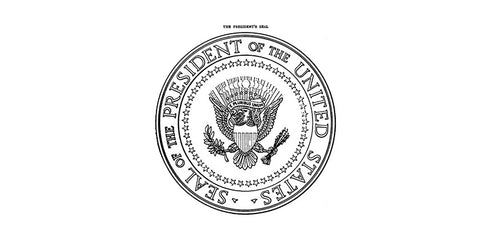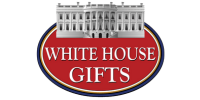The Presidential Seal: A Brief History

The Presidential Seal is the official symbol of the office of the President of the United States. It includes the President’s coat of arms, an eagle on the great seal, a ring of stars and the words, Seal of the President of the United States.
Description and Symbols
The eagle’s right (or dexter) talon clutches an olive branch with 13 olives and 13 leaves to represent peace. The left (or sinister) talon clutches arrows which represent the need sometimes to go to war to protect the nation.
The eagle holds a ribbon bearing the words “E Pluribus Unum,” the motto of the U.S., which means “out of many, one.” The number 13 is used to represent the 13 original colonies.
A shield in front of the eagle has 13 red and white stripes, again representing the colonies, with a blue bar above, representing both the unity of colonies into one nation and Congress, which makes laws for all.
Above the eagle is a “glory Or” or halo of gold. In it are 13 white clouds, 13 white stars and many tiny stars. The 50 stars on a field of deep blue circle the eagle and represent the 50 states. The words, "Seal of the President of the United States" surround the seal on a tan field.
Usage
Today it is used on all correspondence from the president and as a symbol of the presidency. The seal is often seen on the podium where the president speaks, on the side of the Air Force One, Marine One, and the limousine in which the president rides. It is mounted in the center of Oval Office ceiling and on the iconic rug on the Oval Office floor. When the President leaves the Blue Room to speak to the media, the seal is visible mounted above the doorway. One may also see the seal on the reverse side of the Kennedy half dollar.
History
The origins of the seal are vague, but it is believed to have originated with the seal used by the President of the Continental Congress, a small oval with a constellation of 13 stars surrounded by clouds. It was used to seal envelopes containing correspondence sent to the Continental Congress. There is no documented history of the changes made to the seal over time, although a seal used by Andrew Jackson appears to have been similar: a small, round, red wax seal with a circle of clouds. The rest of the design is lost.
The first documented work on the design was by President Millard Fillmore, in 1850. He sketched a drawing of an eagle "displayed with wings inverted," that is, with its wingtips pointed down, holding an olive branch and three arrows.
Edward Stabler, a postmaster in Sandy Spring, Maryland, who had made other seals for the Senate and Congress, made a seal with 31 stars, after California became a state in 1850. Daniel S. Lamont, President Cleveland’s secretary, described a smaller one with 27 stars, called “the old seal.” The arc of the clouds on these seals is similar to Indian Peace Medals that Washington distributed during his presidency.
President Rutherford B. Hayes was the first to use the seal, putting it on invitations to White House events.
In 1945, President Harry Truman began making important changes throughout the U.S. government, including changes to the Presidential Seal.
He ordered that the eagle be changed to face the olive branch, rather than the arrows. At the time, Truman was creating the Defense Department to replace the former War Department and Navy Department, and he wanted the seal to reflect an emphasis on the pursuit of peace.
An earlier (pre-Truman) version in bronze sits above door to Diplomatic Reception Room. In 1903, this bronze seal was embedded in the floor in White House entrance hall, underneath the lantern. President Truman dislike seeing visitors walking on the seal and had it moved during the renovations of 1948-52.
That earlier version is on the “Resolute desk” in the oval office. Queen Victoria of England gave the desk to President Hayes in 1880, but it had no front panel. President Franklin Roosevelt requested that a panel be inserted in the knee hole of the desk to hide the fact that he was sitting in a wheel chair.
The current design was defined in an executive order by President Eisenhower in 1960, when Hawaii became the 50th state and the 50th star was added to the seal.
